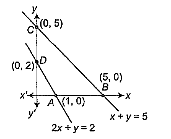 Multiple Choice Questions
Multiple Choice QuestionsA pair of perpendicular lines passes through the origin and also through the points of intersection of the curve x2 + y2 = 4 with x + y = a, where a > 0. Then a is equal to
2
3
4
5
If 3x2 - 11xy + 10y2 - 7x + 13y + k = 0 denotes a pair of straight lines, then the point of intersection of the lines is
(1, 3)
(3, 1)
(- 3, 1)
(1, - 3)
The number of points P(x, y) with natural numbers as coordinates that lie inside the quadrilateral formed by the lines 2x + y = 2, x = 0, y = 0 and x + y = 5 is
12
10
6
4
C.
6

The total integral points lies inside the quadrilateral ABCD is (1, 1), (1, 2), (2, 1), (2, 2), (1, 3), (3, 1).
The line joining the points A(2, 0) and B(3, 1) is rotated through an angle of 45°, about A in the anti-clockwise direction. The coordinates of B in the new position
(2, 2)
If one of the lines in the pair of straight line given by 4x2 + 6xy + ky2 = 0 bisects the angle between the coordinate axes, then k ∈
{- 2, - 10}
{- 2, 10}
{- 10, 2}
{2, 10}
If s and p are respectively the sum and the product of the slopes of the lines 3x2 - 2xy - 15y2 = 0, then s: p is equal to
4 : 3
2 : 3
3 : 5
3 : 4
If the lines 3x + 4y - 14 = 0 and 6x + By + 7 = 0 are both tangents to a circle, then its radius is
7
If the circle x2 + y2 + 8x - 4y + c = 0 touches the circle x2 + y2 + 2x + 4y - 11 = 0 externally and cuts the circle x2 +y2 - 6x + By + k = 0 orthogonally, then k is equal to
59
- 59
19
- 19
